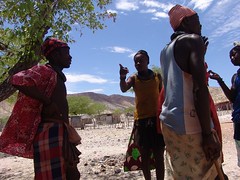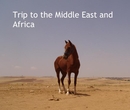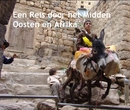Further thoughts.....
So, we had a look at what we did up in Kaokoland and Damaraland, but we didn’t really mention how it felt to be in such wild and magnificent country. Wild in that all the roads were gravel or rocky, the main form of transport for locals is foot or donkey cart and where one would see another car maybe once every hour or two and where there are large distances between one town and another.
Striking were the colours of the landscape, the pinks and purples of the sunsets, the yellows of the orioles and the weaver birds, the reds of the Himba people, the blues of the sky and the sky reflected in the water, the greens of the mopane and baobab trees, of the still water pools, of the reeds at the river’s edge, the reds of the rocks, combined with black, ochre, white and grey, the black and white of the Zebra Mountains, of the pied chats and pied kingfishers, of he markings of the oryx, the greens, blues and pinks of the bee-eaters, the oranges of the Wilwitschia flowers, the warm browns of the giraffe and the lighter browns of the springbok, the colours of the rainbow crashing into the road ahead and the whiteness of the moon shining at night.
Very old is the landscape, massive plains, out of which arise beautiful mountains of granite and basalt, all shaped one way or another, desert would become grassland and then woodland, from one kilometre to another, water would escape from the rocks where it had been held for centuries, to form a river or a stream, only to disappear again, small waders would appear at the water’s edge, accompanied by plovers, ducks and geese before the landscape turned dry again. The giraffes and the elephants are smaller here, for living in the desert, joined by rock dassies, ground squirrels and the oryx, THE animal of the desert. All the time the countryside would change, black rock becoming white, becoming red, all bent out of shape. How did all this happen? What forces have been at work over the last millions and millions of years to give so much diversity? Surely all the rock sediments had been laid down one by one, next to each other and yet millions of years later they have been torn apart and patched together again to give us the landscape we see today.
There was plant to think about as we travelled through these lands.
Striking were the colours of the landscape, the pinks and purples of the sunsets, the yellows of the orioles and the weaver birds, the reds of the Himba people, the blues of the sky and the sky reflected in the water, the greens of the mopane and baobab trees, of the still water pools, of the reeds at the river’s edge, the reds of the rocks, combined with black, ochre, white and grey, the black and white of the Zebra Mountains, of the pied chats and pied kingfishers, of he markings of the oryx, the greens, blues and pinks of the bee-eaters, the oranges of the Wilwitschia flowers, the warm browns of the giraffe and the lighter browns of the springbok, the colours of the rainbow crashing into the road ahead and the whiteness of the moon shining at night.
Very old is the landscape, massive plains, out of which arise beautiful mountains of granite and basalt, all shaped one way or another, desert would become grassland and then woodland, from one kilometre to another, water would escape from the rocks where it had been held for centuries, to form a river or a stream, only to disappear again, small waders would appear at the water’s edge, accompanied by plovers, ducks and geese before the landscape turned dry again. The giraffes and the elephants are smaller here, for living in the desert, joined by rock dassies, ground squirrels and the oryx, THE animal of the desert. All the time the countryside would change, black rock becoming white, becoming red, all bent out of shape. How did all this happen? What forces have been at work over the last millions and millions of years to give so much diversity? Surely all the rock sediments had been laid down one by one, next to each other and yet millions of years later they have been torn apart and patched together again to give us the landscape we see today.
There was plant to think about as we travelled through these lands.
Labels: Namibia, Trip to Middle East and Africa





0 Comments:
Post a Comment
<< Home